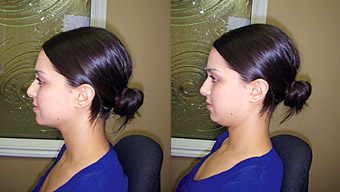Recent guidelines and other research have shed light on some of the effective treatment strategies for chronic neck pain.1-2
However, most of the exercises that are designed to provide favorable outcomes can be accomplished in a typical chiropractic treatment room with specific, gentle exercise strategies. Initial rehabilitation goals are to address muscular imbalances that can be a contributing factor in the development of chronic neck pain. Let's focus on how to develop an effective screening process and initiate an appropriate exercise program to resolve patients' pain.
Deficits in Motor Control of the Neck Flexor Muscles
With respect to muscular imbalances, research has identified deficits in motor control of the deep (longus colli and longus capitus) and superficial (SCM and anterior scalenes) neck flexor muscles, which results in reduced activity of the deep flexors and overactivity of the superficial flexors.4-6 Furthermore, the deep flexors also display reduced isometric endurance.7 Research has shown that those with chronic neck pain have a delayed activation response of the deep flexors associated with voluntary arm movement.8
Since the deep cervical flexors are important for support of the cervical lordosis and joints, the cervical spine can be vulnerable to reactive forces from arm movements. Altered movement patterns of these muscles has also been demonstrated in patients with chronic headaches.9 Adding a training program that addresses these muscular imbalances to conventional therapy has been shown to significantly reduce headache frequency, intensity and duration.10 This muscular imbalance has also been implicated in poor sitting posture, which can be responsible in the development and perpetuation of neck pain symptoms.11 One study showed that exercises targeted at training these muscles demonstrated an improved ability of the neck pain patients to maintain a neutral cervical posture during prolonged sitting.
Screening for Muscle Imbalances and Endurance Deficits
Screening for muscular imbalances and endurance deficits is the first step to prescribing an appropriate exercise program. There are several methods in achieving this. Let's take a look at two of them, the cranio-cervical flexion test (CCFT) and the cervical flexion test (CFT).
Cranio-Cervical Flexion Test: The CCFT involves the use of a pressure biofeedback device that can provide valuable feedback on the amount of pressure a patient applies. This involves inflating the pressure feedback tool to 20 mm Hg. The patient then tucks in their chin ("yes nod") for 10 seconds in five incremental stages of difficulty, increasing the amount of pressure by 2 mm Hg increments. One study comparing the performance of this test between subjects with and without chronic neck pain showed that those with neck pain achieved a median pressure of 24 mm Hg, while those with no neck pain had a median pressure of 28 mm Hg.12
Once a patient demonstrates an inability to perform the test to normal values, they are instructed to use the pressure biofeedback device to train their muscles at various incremental levels of pressure, starting at 22 mm Hg and progressing to 30 mm Hg. They are trained to sustain a contraction for a 10-second duration at the highest level they can accomplish without pain or loss of the correct cranio-cervical flexion action. At this level, the goal is to perform 10 repetitions, gradually building up to higher level of pressure.
Cervical Flexion Test: The other way to screen a patient is to use the CFT. While a patient is in a supine position on the table, ask them to tuck their chin in and lift their head off the table. They should try to maintain this position. The test can be graded on a 12-repetition maximum ability. If the patient's head shakes, there may be increased fatigue. If the chin juts upward, it suggests overactivity of the SCM and scalene muscles, indicating a muscular imbalance.

Once a patient is identified as having muscular imbalances, the patient is taught to lift the head off the table for 12 repetitions, with fatigue being the indicator to finish each repetition. The patient can then progress to three sets of 12 repetitions, building to three sets of 15 and finally three sets of 20 repetitions. The goal is to increase endurance of the cervical musculature, in addition to maximizing proper motion.
The question that arises is whether one screening technique is better than the other. One study compared these two exercises on cranio-cervical flexor muscle performance. Results showed that there was no significant difference between the techniques.13 However, the study was limited primarily to mild neck pain. Experience also shows that those with more severe neck pain may not be able to perform adequate chin tucks while lifting their head off the table. If a patient is unable to achieve this, start them on chin-tuck exercises in a seated position, progressing to incline positions that reduce the effects of gravity until the patient is able to perform the 12-repetition max. Either way, the goal of increasing muscle performance can be obtained through both methods.
 The Seated Chin Tuck. As with the lying test, this is a good exercise (left image = starting position; right image = tucked position) for strengthening the neck musculature. Inability to perform the exercise properly may indicate abnormal fatigue of the neck flexor muscles.
Another important consideration is that the CCFT can be utilized for elderly patients, since their performance in the test may be different than those who are younger. A study comparing elderly versus younger patients found there was a greater shortfall from the target pressures of all stages of the test. Being aware of this discrepancy will allow the clinician to progress the elderly patient much more carefully.
The Seated Chin Tuck. As with the lying test, this is a good exercise (left image = starting position; right image = tucked position) for strengthening the neck musculature. Inability to perform the exercise properly may indicate abnormal fatigue of the neck flexor muscles.
Another important consideration is that the CCFT can be utilized for elderly patients, since their performance in the test may be different than those who are younger. A study comparing elderly versus younger patients found there was a greater shortfall from the target pressures of all stages of the test. Being aware of this discrepancy will allow the clinician to progress the elderly patient much more carefully.
Add Neck-Pain Exercise Protocols to Your Practice
As current guidelines indicate exercise as a recommendation for chronic neck pain, more and more clinicians can begin integrating simple exercise protocols within their practice. The CCFT is an effective screening and treatment tool that addresses muscular imbalances. Once the muscular imbalances are addressed, rehabilitation can progress to isometric exercises utilizing resistance bands and full-body conditioning programs that also address the scapulothoracic areas. Integrating these exercise protocols into your treatment program will increase patient recovery and address chronic neck pain as a multi-factorial condition.
References
- Gross AR, et al. Conservative management of mechanical neck disorders: a systematic review. J Rheumatol, May 2007;34(5):1083-102.
- Haldeman S, et al. The Bone and Joint Decade 2000-2010 Task Force on Neck Pain and Its Associated Disorders: Executive Summary. Spine, February 2008;33(4S):S5-7.
- Freburger JK, et al. Exercise prescription for chronic back or neck pain: who prescribes it? Who gets it? What is prescribed? Arthritis Rheum, February 2009;61(2):192-200.
- Falla D. Unravelling the complexity of muscle impairment in chronic neck pain. Man Ther, August 2004;9(3):125-33.
- Johnson V, et al. Alterations in cervical muscle activity in functional and stressful tasks in female office workers with neck pain. Eur J Appl Physiol, June 2008;103(3):23-64.
- Falla DL, et al. Patients with neck pain demonstrate reduced electromyographic activity of the deep cervical flexor muscles during performance of the craniocervical flexion test. Spine, October 2004;29(19):2108-14.
- Jull GA, et al. Clinical assessment of the deep cervical flexor muscles: the craniocervical flexion test. JMPT, September 2009;31(7):525-33.
- Falla D, et al. Feedforward activity of the cervical flexor muscles during voluntary arm movement is delayed in chronic neck pain. Exp Brain Res, July 2004;157(1):43-8.
- Fernandez-de-las-Penas C, et al. Performance of the craniocervical flexion test, forward head posture, and headache clinical parameters in patients with chronic tension-type headache: a pilot study. J Orthop Sports Phys Ther, February 2007;37(2):33-9.
- Van Ettekoven H, Lucas C. Efficacy of physiotherapy including a craniocervical training programme for tension-type headache; a randomized clinical trial. Cephalalgia, August 2006;26(8):983-91.
- Falla D, et al. Effect of neck exercise on sitting posture in patients with chronic neck pain. Phys Ther, April 2007;87(4):408-17.
- Chiu TT, et al. Performance of the craniocervical flexion test in subjects with and without chronic neck pain. J Orthop Sports Phys Ther, September 2005;35(9):567-71.
- O'Leary S, et al. Specificity in retraining craniocervical flexor muscle performance. J Orthop Sports Phys Ther, January 1997;37(1):3-9.
Click here for previous articles by Jasper Sidhu, BSc, DC.





